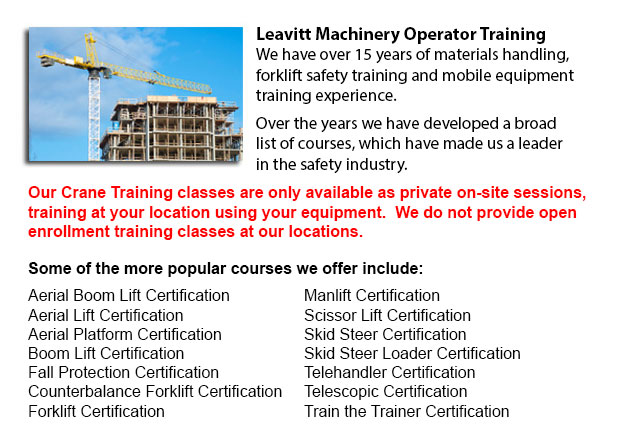
Overhead Crane Operator Training Kelowna - Our overhead crane operator training program is intended to teach staff the fundamentals of overhead crane/sling operation and pre-shift checks. Courses are taught by our expert trainers and consultants. Well-trained employees are more efficient and productive, that actually saves on costs associated with product damage, property damage, and accidents due to the use of improper operating procedures. Our overhead crane certification is customized for workers who have literacy barriers, reducing certification time by 50 percent.
Overhead cranes are suitable for specific repetitive hoisting activities. This kind of crane has wide ranging capacities. They may be used for specialized lifting tasks like installing or removing major plant equipment.
In order to safely operate an overhead crane, workers must employ safe rigging practices. This needs both practice and knowledge. The load must be rigged properly in order to ensure its stability when hoisted. Before beginning a lifting job, it must be determined that the crane is suitable for the job, with right lift, capacity and travel. The crane should be subjected to a thorough visual and physical check before use. The capacity of all machines, including the slings, hardware and rope, should never go beyond load weight capacities.
The rigger needs to know the correct sling for every lift and check slings and other rigging hardware before using. Clear signals must be used in communications with the crane operator. A signaler should be designated for the role and signals have to be agreed upon. The crane operator should follow instructions just from the designated person. If a wired or remote controller is being utilized, the operator should be trained in all its functions.
Prior to any lifting starts, the path of the load must be cleared of all hazards and a warning sign must be issued to guarantee the safety of the personnel. Pedestrian are not under any circumstance allowed to walk under the lift loads. The crane hoist must be centered over the load before lifting to prevent swinging. The safety catch needs to be closed immediately after sliding the sling entirely onto the lifting hook. Sling legs which are not used must be secured so they do not drag. Never leave loose materials on a load being hoisted. Watch that hands and fingers are clear when slack is taken out of a sling. Step clear of the danger zone before the lift is carried out.
-
Counterbalance Forklift License Kelowna
Counterbalance Forklift License Kelowna - Forklifts, when operated by completely trained workers, are a major advantage to companies. We offer a thorough training program consisting of all parts of operating a powered lift device. Counterbalance fork... More -
Forklift Certification Schools Kelowna
Forklift Certification Schools Kelowna - Within North America, forklift certification is mandatory, making forklift training programs important for both the company and their employees working as forklift operators. Forklift training focuses on healt... More -
Manlift Operator Certification Kelowna
Manlift Operator Certification Kelowna - We provide a scissor platform and aerial lift training and certification to empower the trainee with the general understanding and knowledge of the safe and efficient utilization of "Power Operated Mobile Work... More -
Crane Training Schools Kelowna
Crane Training Schools Kelowna - We have designed several programs for Mobile Crane Operation at our Crane Training Schools. These programs are recommended for the experienced operator who requires re-certification or certification, and for inexperie... More -
Heavy Equipment Operator Classes Kelowna
Heavy Equipment Operator Classes Kelowna - A heavy equipment operator is a person who has received the proper training to operate a particular type or piece of machine. There are a lot of ways for the operator to undergo training and certification in... More -
Telehandler, Rotational Telehandler, Zoom Boom Training in Kelowna
Telehandlers or also known as Telescopic handlers are really popular piece of heavy construction equipment normally utilized in agriculture and construction trades. These equipments have extreme reaching capability and could get to places where a tra... More -
Zoom Boom Training Kelowna
Zoom Boom Training Kelowna - Zoom Boom Training is intended to train operators on variable reach forklifts. The goals of the training are to impart an understanding of the physics of the equipment, and to outline the operator's tasks. This course fol... More -
Boom Lift Safety Training Kelowna
Boom Lift Safey Training Kelowna - Boom lifts fall under the type of elevated work platform or aerial lifting device. Most normally utilized in construction, industry, and warehousing; the boom lift is so versatile that it can be utilized in almost w... More

Forklift Training Kelowna
TOLL FREE: 1-888-254-6157
Kelowna, British Columbia
forklifttraininginkelowna.com
Email Us
About Us


